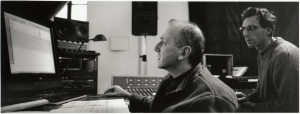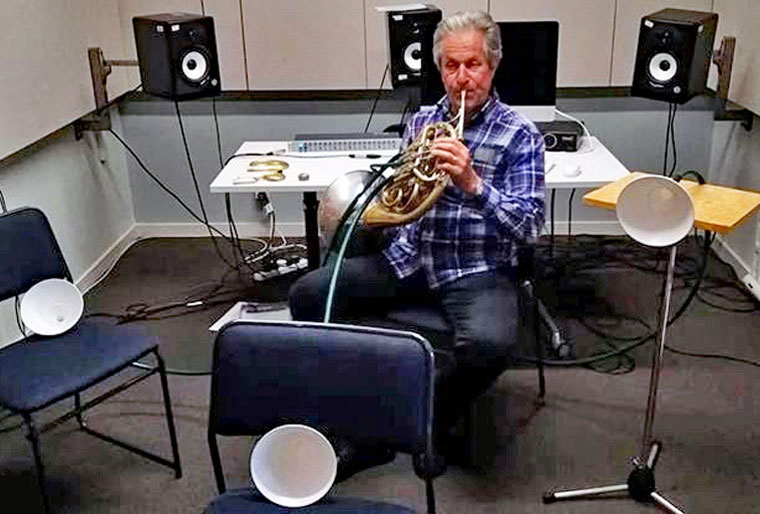Selection ICMC 2000 – Berlin (Germany)
Honorary Mention for electroacoustic music with instruments, Bourges 2000.
commisson: AGON / Centro Studi A.Gentilucci – Fondazione Sergio Dragoni.
1st performance: Milano, Palazzo Reale, Festival Regola Gioco – November 18th 1999
performer: Michele Fait – horn
“Respiri” was entirely created at the AGON studio in Milan on commission from the AGON studio and the “Dragoni” foundation.
A part of the documentary “Auf der Suche nach noch nie gehörten Klângen”, 4 Arten den Computer zu beschreiben (“4 ways to describe the computer”, Looking at sounds never heard before)), Film by Uli Aumüller and Gôsta Courkamp (Bayerisches Fernsehen / inpetto filmproduktion © 2001).
performances of Respiri
Nov 18, 1999 – Milano (Italy), Palazzo Reale, Festival Regola Gioco
Jun 02, 2000 – Bourges (Fra), Festival IMEB
Aug 29, 2000 – Berlin (Germany), ICMC Festival, St.Matthaus-Kirke
Oct 01, 2000 – Roma (Italy), Festival di Nuova Consonanza
Oct 26, 2000 – Cordoba (Arg), Encuentro Internacional de Música Electroacústica
Oct 28, 2000 – Weimar (Ger), Tage Neuer Musik, Festsaal des Furstenhauses
Apr 12, 2001 – Montréal (Canada), Rien à voire, Ex Centris 2
May 01 2001 – Jena (Ger),Der Kino for der ohren, Theaterhaus
Apr 07, 2002 – Wellington (NZ), Digitalia, Te Whaea, Newton, Ed Allen horn
Dec 22, 2003 – Milano (Italy), Palazzina Liberty, L’evento del sentire
Nov 16 2017 – Wellington (NZ), Stroma – concert “Spectral Electric” , City Gallery, Ed Allen horn
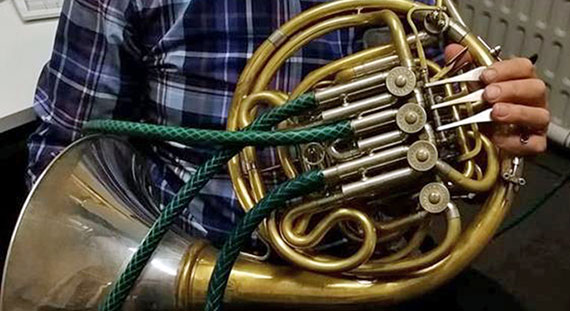
In SPECTRAL ELECTRIC, Luigi Ceccarelli’s piece Respiri requires the insertion of hosepipes into the horn, each of which is attached to a funnel, and miked separately. When each of the microphone signals is sent to a loudspeaker in a different corner of the room, the result is rapidly panning horn sounds that swirl around the listeners!
notes on the making of “Respiri” (Breaths)
Each step of evolution is an addition of information to an existing system. For this reason the combinations, harmonies and discrepancies between successive elements and layers of information will present many problems of survival and will determine many directions of change.
Gregory Bateson (Mind and Nature)
The following description briefly tells the steps that led me to the creation of “Respiri”. The first part, divided into two chapters, does not directly concern the piece, but is perhaps the most important because I consider it a fundamental premise for all my work as a musician. The second part describes the creation of the piece in a mainly technical way, even the technique is always inextricably linked to the becoming of the musical idea and the two things inevitably go hand in hand.
At the beginning of a new composition I never really know what will happen in the end, what the final result will be. It’s like setting out on a long journey: you know when you’re leaving, but then events and new discoveries lead you to alter many of your plans
At the end the object is so complex that you cannot contemplate the whole “all in one go”. And for me too the only way to understand it is to listen to it again each time.
With a wind instrument it is breath that generates the sound. Only after the player has produced the sound may it be modified with the instrument by means of a technique that combines blowing, lip tension and movement of the tongue and fingers. Player and instrument are part of a single complex machine, the millenary and continuous perfection of a technique devoted to the aesthetics of listening.
What urged me to write a piece for horn was precisely this close relationship between man and machine which, with the horn, achieves one of its highest levels, the French horn being the most evolved instrument of the brass family.
But machines are not necessarily finished objects. Just like razors, trains and telescopes,
musical instruments too may be manipulated and perfected without limit. Strangely, though this viewpoint is generally accepted for everyday technology, it is much less so when applied to musical instruments. It seems that musical instruments must always remain as they are: they change so slowly that it is almost imperceptible.
The experience of musicians and instrument makers of the past is certainly a heritage that cannot be renounced, but from this inheritance we must set out in search of new techniques which permit their modern counterparts to increasingly broaden the horizons of musical expression.
Musicians have discovered new, unexplored paths of creation through the combination of mechanical and electronic technology. And this exploration is only at its first hesitant steps in a universe of endless possibilities. We can never imagine what the music of the future will be like.
(unless it happens to be an organised trip, something I’ve always detested).
At the beginning of a new composition I never really know what will happen in the end, what the final result will be. It’s like setting out on a long journey: you know when you’re leaving, but then events and new discoveries lead you to alter many of your plans (unless it happens to be an organised trip, something I’ve always detested).
I don’t believe, as happens in Milos Forman’s film on Mozart, that a composer can imagine an entire composition in his head. If it were so, the music would certainly be too banal. For me a musical composition must grow gradually with time, working on the sounds step by step through presuppositions, verifications, errors, random discoveries, disillusions, illuminations. Without a rational logic, then, but with a constant and inexorable process of growth.
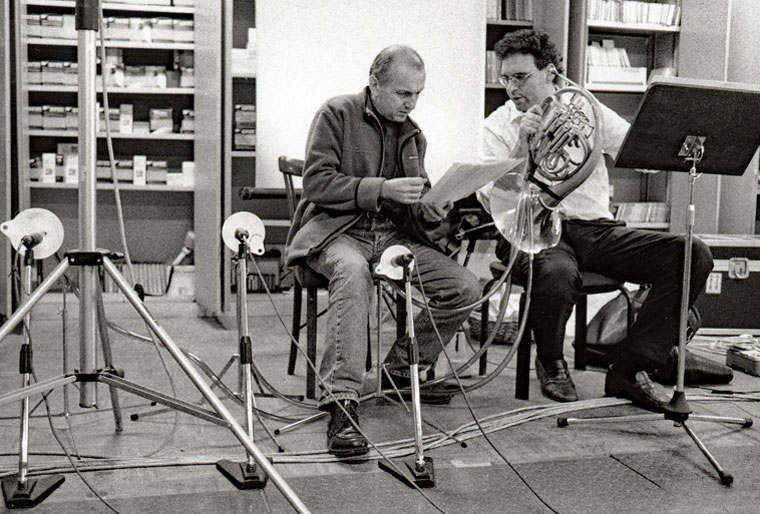
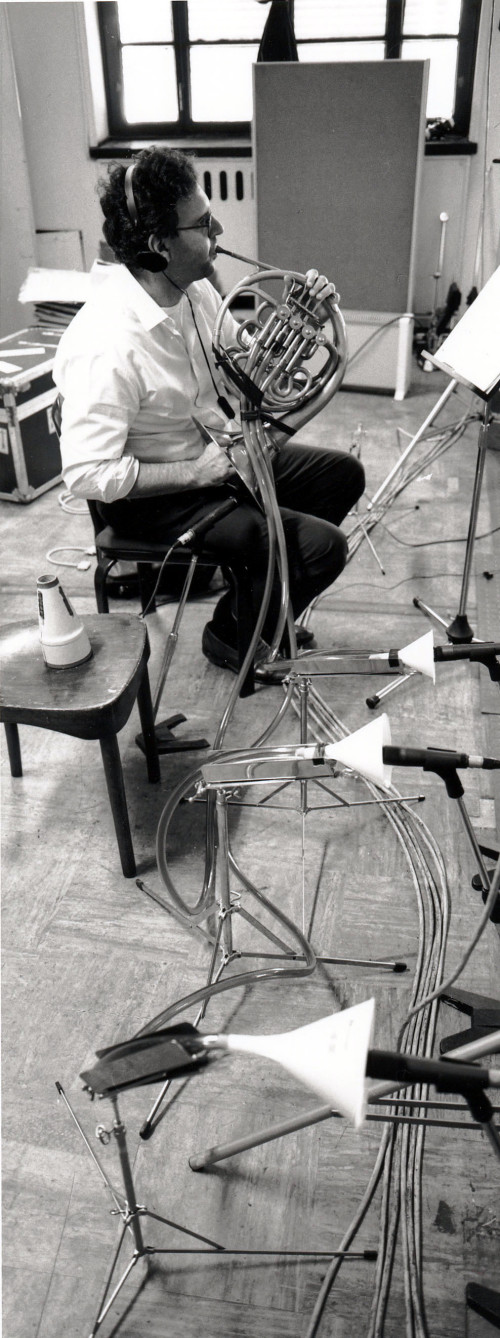
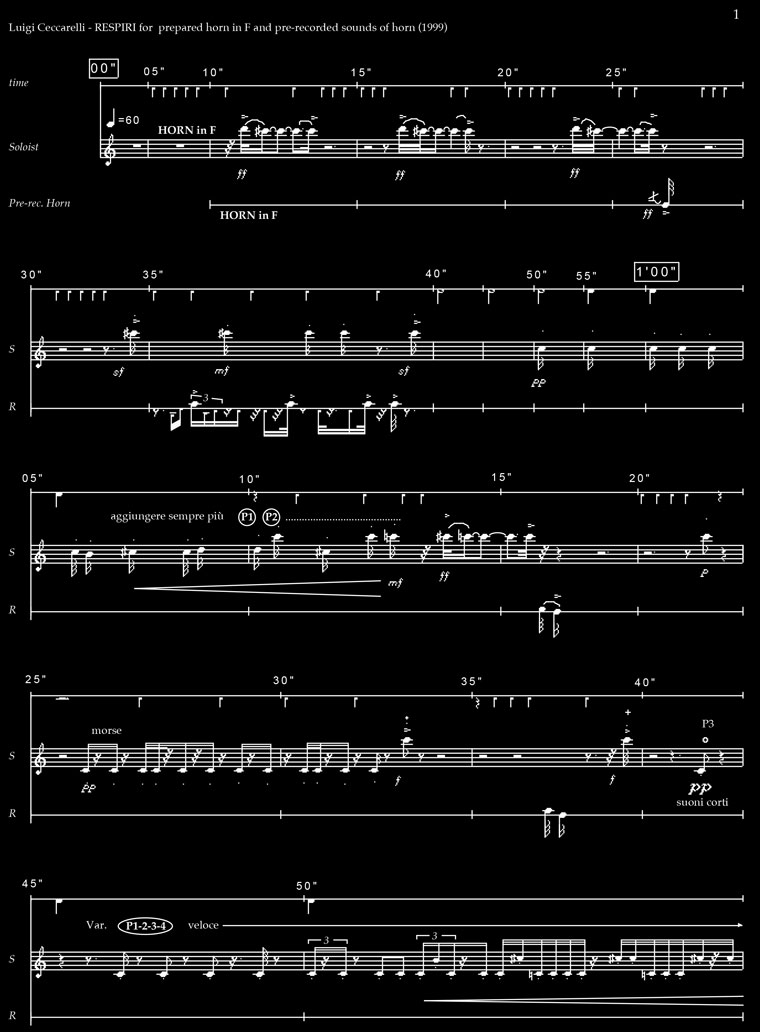
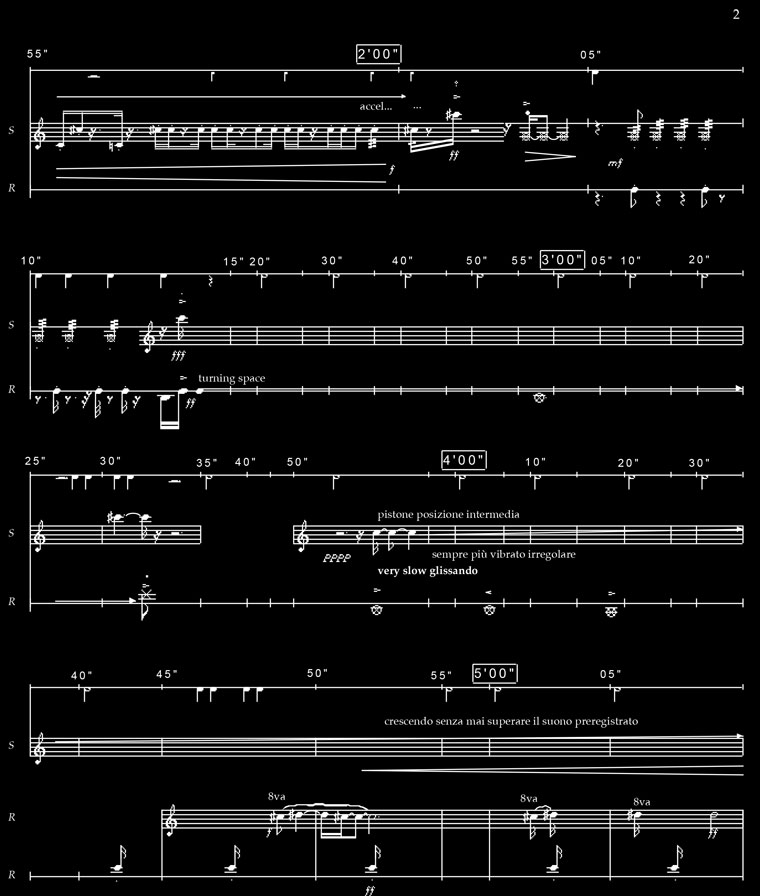
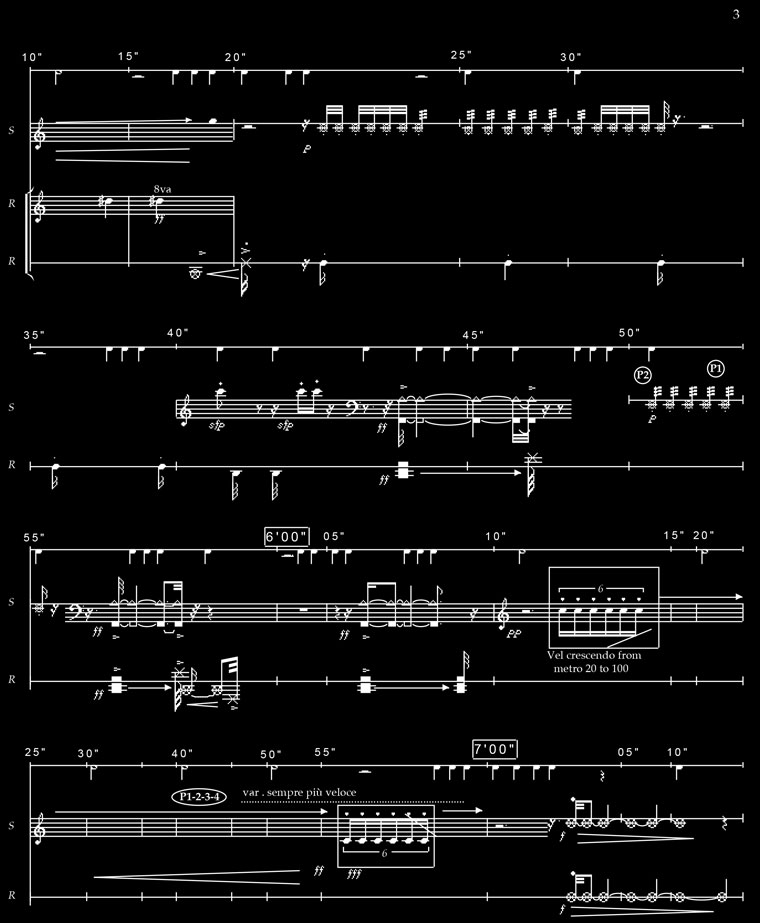
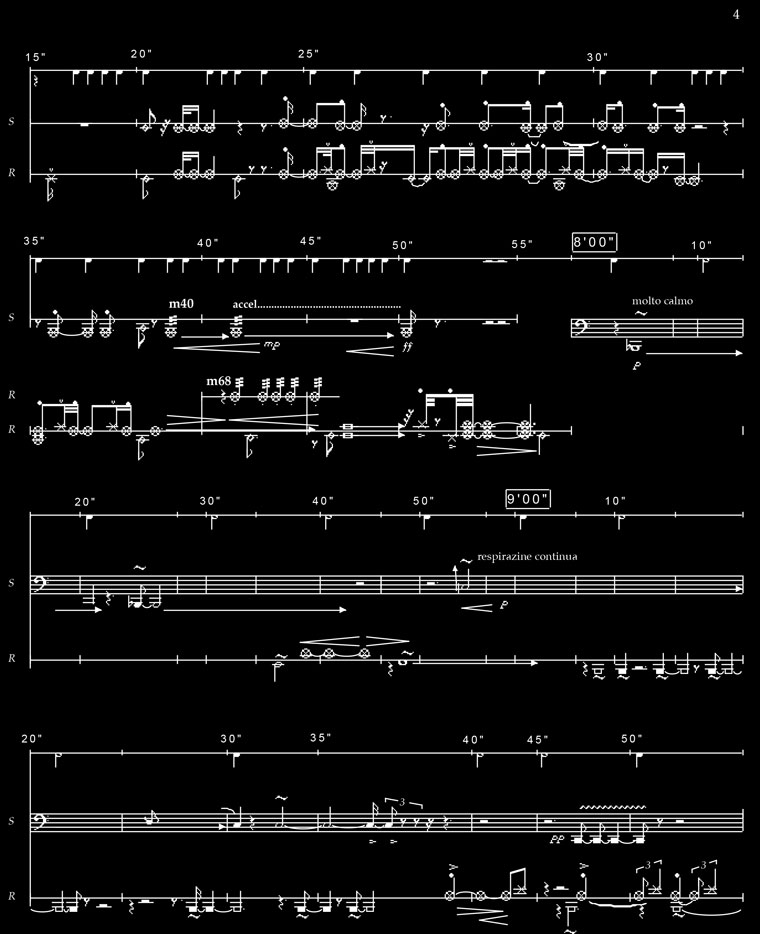
Technical realization
“Respiri” is a piece for horn sounds: a live soloist plays a horn prepared and amplified with various microphones. Other horn sounds, previously recorded and processed in the studio, are diffused into the space by a system of ten independent speakers. The main idea of the work is to recreate a multitimbral and polyrhythmic piece with a single traditional instrument that starts entirely from the sounds of the horn and, with the help of electroacoustics, reaches expressive possibilities equal to those of a large symphony orchestra. In this work there is a great variety of sounds that form layered rhythmic and timbral patterns. The distribution of sounds in space develops around the listener, who is completely immersed “in” the sound, and thus has the possibility of perceiving extremely complex structures, which would be completely lost in a mono or stereo diffusion.
Part I – Technical realization of the pre-recorded part.
Recording of horn sounds
To obtain the basic materials of the non-live part, only sounds from the horn bell were used. As a first operation, a large number of sounds of the instrument were recorded in the studio, trying to obtain very different samples and trying to exploit all the possibilities of register, timbre and intensity. The recording was carried out with two condenser microphones very close to the bell, so as to be able to pick up, in addition to the sound that is normally classified as such in music, also all the small noises of the instrument’s mechanics and those produced by the breath of the performer. . This method of recording was very important: shooting with very close microphones is like an acoustic magnifying glass, and so listening to this piece the listener sometimes has the feeling of being inside a giant horn.
Timbre
In “Respiri” great importance was given to the timbre, both in the live and in the pre-recorded part. The timbre varies from the typical sound of the instrument to the more unusual sounds introduced by the music of the 1900s. In order to obtain as much as possible sounds with a clear spatial localization, many repetitions were recorded: regular rhythmic sequences, in accelerating or slowing down, sequences with rhythm or pitch varying randomly within assigned limits. Tongue strokes and hand strokes on the mouthpiece were also used, to obtain exclusively percussive sounds. On the contrary, very long and kept sounds have been used, trying however to continuously vary the density and the internal spectral ratios. Again, the breath parts that are present in the sound have been emphasized. To make the harmonic spectrum of certain sounds even more complex, the mouthpiece of the horn was replaced with a double bassoon reed. Although difficult to control, the sound produced is harsher and more aggressive and has an extreme tonal density.
Heights
The reference system used for the heights does not take into consideration the tempered system, but the harmonic series, in accordance with the constructive principle of the horn. The whole piece is built on a fundamental reference harmonic sound which is obviously the F, horn pedal sound. However, the precise intonation has never been respected and the sounds are often free to move and float in a microtonal range that moves more or less wide ranges around the harmonic series. These small variations have been freely established, without ever being measured in a rational way and according to the need to create tensions and emotional relaxation.
Processing
All pre-recorded horn sounds have been electronically processed. The aim that guided this phase of work was to reveal the internal structure of the timbre of each sound; this was generally done by slowing down the sounds so as to make the variations of the attack transients perceptible to the human ear, which usually occur too quickly to be clearly heard. The main processing techniques used are time-stretching (time dilation) and pitch-shift (height shift). These two techniques are the basis of many more or less commercial software and, to obtain effective processing according to the different sounds, several have been used. In particular, GRM Tools was used, a software that allows great time-stretching variations instant by instant in a very simple and versatile way. With GRM Tools, sequences of sounds repeated in accelerating and slowing down have been created that gradually reach such a speed as to become practically continuous sounds.
Spatialization of the horn sounds in studio
For the diffusion of the prerecorded part, a speaker system is provided with at least six independent diffusion points placed around the listeners and possibly different from those used for live horn amplification. The voices of the Pro Tools score and the samplers have been organized in a pattern of movement in space. Of the six diffusion points provided, four are placed in a square (front left and right, back left and right) and are used to simulate a two-dimensional space in which sounds can move following continuous two-dimensional trajectories. Two other listening points are placed on the sides of the audience to diffuse static stereophonic sounds. The rhythmic sequences of repeated sounds are particularly suitable for simulating the movement of sound in space, because the localization of sounds with very short transients is very effective, while it is practically unnoticeable in held sounds that have a slow attack and slow timbral variations.
Technical notes on studio work
The final realization of the magnetic tape of the pre-recorded part of “Breaths” was stored on tape in Adat format, and was made at the Agon studio. During the work, various technical problems of a certain complexity arose, which could only be solved in a well-equipped studio. Once the materials assembly phase was complete, it was a matter of distributing the eight Pro Tools outputs and the eight sampler outputs in space, all with independent and synchronized spatial movements. Two different computers and a digital mixer were used to solve this problem. One of the two computers managed the reading of the sounds with Pro Tools and Notator Logic software (for managing the Midi data to be sent to the samplers). The audio outputs of the samplers and Pro Tools went into a Yamaha 02 digital mixer and through its four-channel spatialization system (plus two other output buses) the signals were spatialized and stored on six tracks of the Adat recorder. The second Macintosh computer was used to automatically manage via Midi all the assignments and pan movements of the sixteen inputs of the mixer towards the outputs. To do this, “Max” was used, a programming language, with which Agon has specifically created a management software for mixer 02. This management software generates movement sequences for the quadraphonic pan of the mixer. The basic simple sequences are already inserted as presets (for example the movement from one channel to another in a certain number of seconds or the continuous circular movement at a constant speed or the random movement between the four outputs), while particularly complex sequences they can be drawn directly with the mouse, stored and recalled at will. The starting instant of each movement for a specific input channel is established by sending a Midi message to Max. The channel number of the message indicates which of the sixteen inputs of the mixer is changed, while the control number is used to make each channel perform 128 different sequences. Since all these operations had to be synchronized with each other, the messages were written on the sound management computer, in the same Logic session used for the samplers, and from there sent via Midi to the spatialization software.
Part II – The solo horn part
The modification of the French horn.
The function of the modified French horn in the live part is essentially spatial. The problem was to create a number of different sources of the sound of the single instrument in spite of its natural acoustic qualities as, like all traditional instruments, it does not have this possibility without the use of electronic amplification and it is generally used as a spatially isolated element within a larger instrumental ensemble.
The solution adopted was to apply three extra bells or funnels to the instrument, each with their own separate tubings, allowing the performer to freely decide which bell the generated sound would be transmitted to.
Technical description
The three cylindrical casings of the horn that house the piston-valves which vary the length of the tubing, and thus the pitch, are unscrewed and opened at the bottom (only the Bb thumb valve is left intact). To these, three plastic pipes are fitted, which function as alternative tubings and which lead to a funnel at the other end. When the instrument is played and a piston is pressed, the valve opens, air passes into the relative tubing and the sound leaves the corresponding funnel instead of the original bell. The pitch of the sounds produced is not substantially altered as it did before but remains roughly at the tonic note of F, while the timbre changes according to the dimensions of the tube and especially according to the shape of the funnel-bell (obviously the sound coming from the new funnel-bells is of a lower quality than those of the original normal horn). This modification is based on onw used for a composition in the early eighties by the Canadian composer David Keane.
Spatialization and amplification of the horn
Thanks to the three additional sets of tubing, plus the metal tubing of the original instrument, the performer can send the sound in four different directions while he plays from the score. This variation of direction can be very fast, since the same techniques are employed as those that are traditionally used for changing the pitch of the notes played. The sound coming from the four bells (with the three extra funnel-bells) is then amplified with four microphones connected to four different speakers, which are placed in variosu postiions in the room around the listeners, helping the latter to perceive the spatial shifts of the sounds even more clearly. Thanks to this technique it is also possible to perform sequences of notes at a speed that is normally impossible for the instrument, and to produce a kind of tremolo between one amplified funnel and another.
Composition
The composition of the score was not made on paper, but directly on the computer using the Pro Tools environment. In this way it was possible to check the sound result of the composition moment by moment and experiment with different solutions, deciding the actual final result based on listening. On Pro Tools, during the composition phase, the execution of the live horn player was also simulated. In addition to Pro Tools, two samplers with over two hundred very short-lived horn samples were also used. These sounds were used to create the most irregular rhythmic sequences and to obtain very dense sets of pitches that vary in a stochastic way. These parts were made with software that sends instructions to the samplers according to the Midi code and is synchronized by Pro Tools. The composition of these sequences follows controlled risk criteria both in terms of heights and intensities and durations. The composition thus created has a variable density from one to about thirty different overlapping voices.
.
